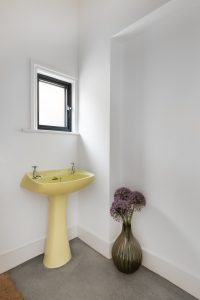Six Tips for Designing a Truly Sustainable Interior
< Back to InsightsCreating a sustainable interior design goes beyond just selecting eco-friendly materials and buying new furniture from trusted green suppliers; it’s about adopting a holistic approach that seeks to change as little as possible, but still have a big impact. This will minimise waste and conserve resources, which has a greater impact than throwing out something old and replacing it with something new and “green.”
Here are some tips to help you to create truly sustainable interior design without falling into the trap of greenwashing.
1. Avoid trends
Start the interior project by really diving into what brings you joy, what agrees with you, what spaces and rooms do you return to in your mind. Following trends and fashion is a quick way to create something that will quickly date. Work with the qualities of the existing building: what historic features are there to celebrate, what is the quality of the daylight, are there any surfaces that are still in good quality? The first step in creating a sustainable interior is marrying this with your individual preferences – not recent design trends.
2. Embrace the Three R’s: Reduce, Reuse, Recycle
Reduce: Start by minimising the scope of your project and really question what the interior design wants to achieve. A good designer can create a big impact with limited resources.
A feeling of spaciousness can be achieved by decluttering or adding bespoke joinery, not necessarily by knocking down walls.
Look at the existing property and aim to incorporate as much as possible of the existing. Minimise construction if you are only working with the interior. If you consider a full retrofit of the building, adopt a fabric first approach.

Reuse: Before discarding old furniture and décor, consider how they can be repurposed or refreshed. Can existing joinery items be tweaked, or repurposed by a good joiner? Is the sanitaryware in good enough condition to be reused in an upgraded bathroom? Can the existing floor be sanded and varnished? Can the kitchen be upgraded with new fronts, or just new handles? Reuse should always be considered before recycling, it is beneficial for the planet, and for your wallet.

Another example: incorporate treasured object. Red chinoiserie cabinet fitted with new bespoke joinery.
Recycle: For new elements, whether it is building materials or pieces of furniture and fabric, make sure it can be recycled, and that it is made of recycled materials.
There is an increasing number of suppliers that incorporate recycled materials in their new products, such as Smile Plastics, Foresso, Eco Friendly Tiles, Who all make products with a very high percentage of recycled content.
3. Choose Sustainable Materials
When using new materials, opt for materials that are renewable, have low environmental impact, and are durable. Timber is always an excellent option as trees capture and store carbon. Opt for reclaimed timber when you can, if you are purchasing new timber opt for locally grown (to avoid transportation) FSC certified timber.
If a local softwood does not have the look and feel you are after, consider using a Satin Wood Oil that can create almost any look, and mimic rare hardwoods that should not be used.
4. Prioritise Quality Over Quantity

Investing in high-quality, timeless pieces ensures longevity and reduces the need for frequent replacements. Well-made furniture and fixtures might come with a higher upfront cost, but they save money and resources in the long run, and can often be sold on if no longer needed.
5. Energy Efficiency is Key
Incorporate energy-efficient lighting and appliances to reduce energy consumption. Use LED bulbs, which last longer and consume less power. Companies such as Orluna lighting offers circular products and repair service, as well as designs and controls that dim to warm to support circadian rhythms. Consider installing programmable thermostats to optimise heating and cooling, and internal blinds and curtains to insulate during the cooler months, and prevent overheating in the summer months.
6. The power of Paint and Finishes
In an interior project it is very likely that painting walls and ceilings is part of the project scope. Using paint as a design tool is a low impact way of creating a unique interior without the environmental impact. Choose low-VOC (volatile organic compounds) or zero-VOC paints and finishes. These products emit fewer harmful chemicals, contributing to better indoor air quality and overall health. British brands such as Mylands and Graphenstone have low VOCs and Dulux have just released their Airsure range.

Designing a sustainable interior is about making mindful choices that respect the environment, and should also promote health and well-being. By reducing waste, reusing materials, choosing eco-friendly materials and suppliers, and supporting local makers and craftspeople, you can create a beautiful, sustainable interior that stands the test of time.
Interested on making a big impact on your home, with a small impact on our environment? Get in touch to talk to us about your sustainable interior project.
Let’s have a chat about your vision and
how we can help you realise it.
Collective Works are an architecture & design studio. Our network of professionals will create your perfect solution.